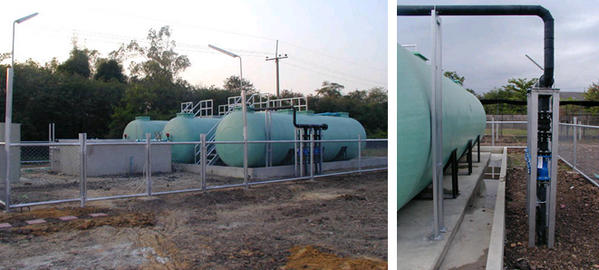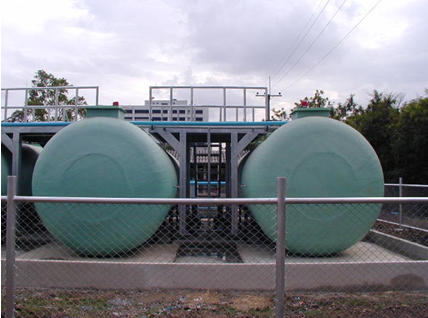Wastewater Treatment
ระบบบำบัดน้ำเสีย ระบบกำจัดไขมัน และน้ำมัน ระบบบำบัดน้ำเสียด้วยวิธีทางเคมี (Chemical Treatment System) ระบบบำบัดน้ำเสียด้วยวิธีทางชีวภาพ (Biological Treatment System)
On-site Treatment Plant
A typical Onsite Wastewater Treatment System (OWTS) consists of a septic tank and a soil absorption field that allows treated effluent to infiltrate into the soil. When functioning, these systems are effective at removing pollutants before they enter into the environment. However, it has been determined that due to geological and hydrological conditions, 2/3 of the U.S. is unsuitable for septic systems (USEPA, 2002). Costly system failures and the release of pollutants may result if a septic system is improperly sited. Fortunately, many alternative technologies have been developed for situations where conventional systems are not appropriate.
Treatment Units;
1. Aerobic Treatment Unit
In an Aerobic Treatment Unit (ATU) wastewater enters a compartment where solids settle and are partially digested by microorganisms. A motor pumps air into the chamber and mixes the liquid, facilitating diffusion of air and supporting aerobic bacteria that further degrade the wastewater. The treated effluent exits the ATU for additional treatment and dispersion through a soil absorption field.
2. Fixed-Activated Sludge Treatment
Fixed-Activated Sludge Treatment (FAST) systems are similar to aerobic treatment units that fit inside preexisting septic tanks. The wastewater cycles between the oxygenated FAST system and the septic tank. This recycling action causes microorganisms to convert ammonia and nitrates into nitrogen gas, an inert and abundant atmospheric gas. Because the FAST unit features recycling of effluent, it is more effective than a single-pass ATU at removing ammonia and nitrates.
3. Recirculating Sand Filter
The Recirculating Sand Filter (RSF) utilizes an additional treatment stage beyond the conventional septic system. Effluent from the septic tank is pressurized and sprayed on a volume of sand. Microorganisms break down organic matter and convert ammonia into nitrate as the effluent filters through the sand. When the effluent reaches the under drain, a portion of the water enters the soil absorption field and the rest re-circulates through the septic tank, where the nitrates are converted into nitrogen gas, an inert gas that can be vented to the atmosphere.
4. Trickling Filter
In trickling filters, also known as fixed-film reactors, microorganisms typically grow on a specially designed synthetic material, such as a plastic polymer, instead of being carried with the liquid, as in a typical septic system.
5. Sequencing Batch Reactor
The sequencing batch reactor (SBR) is particularly successful at the removal of nitrate, phosphorus, and ammonia. The design principle consists of a series of processes that occur in sequence in a single underground unit. During the treatment cycle no additional influent is allowed to enter the unit.





